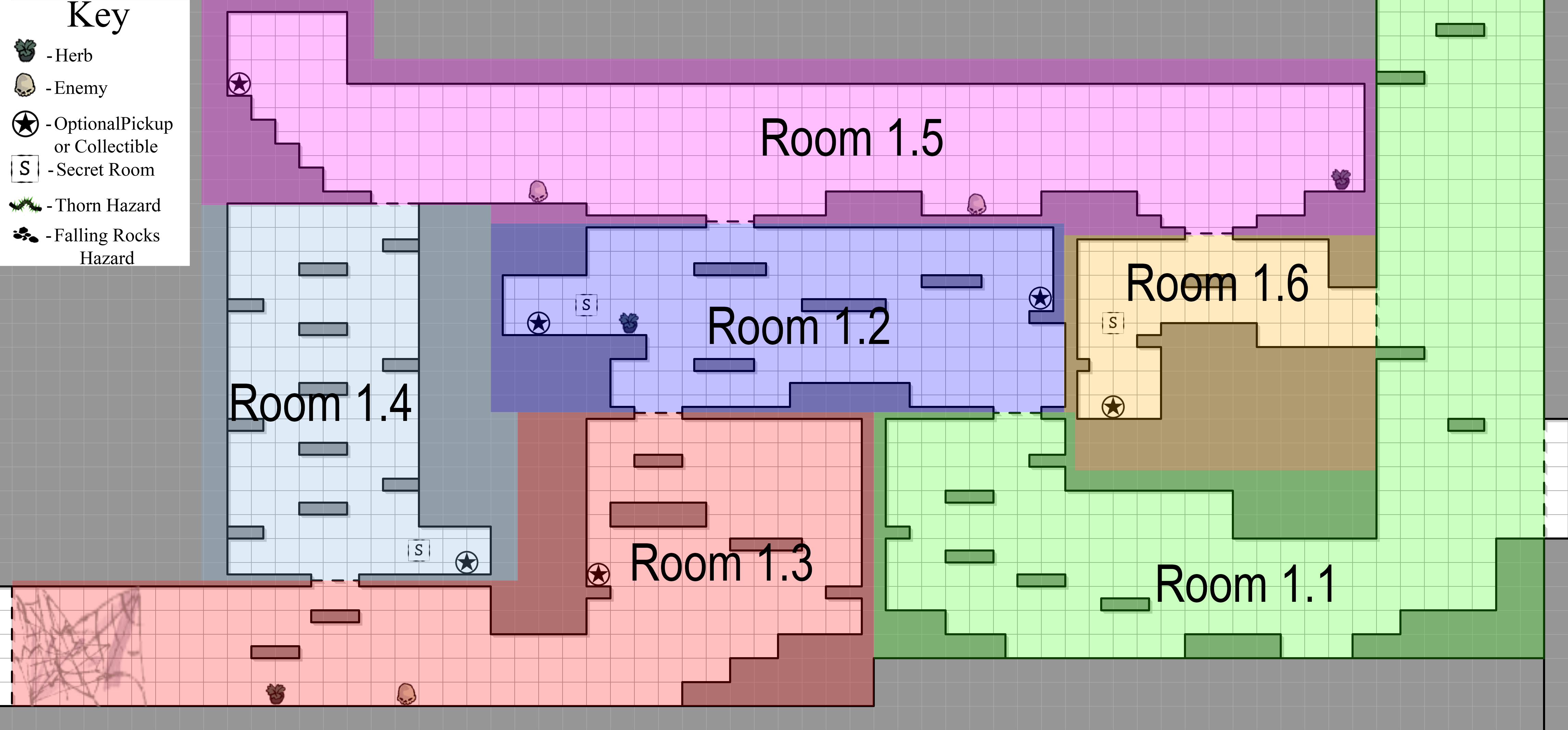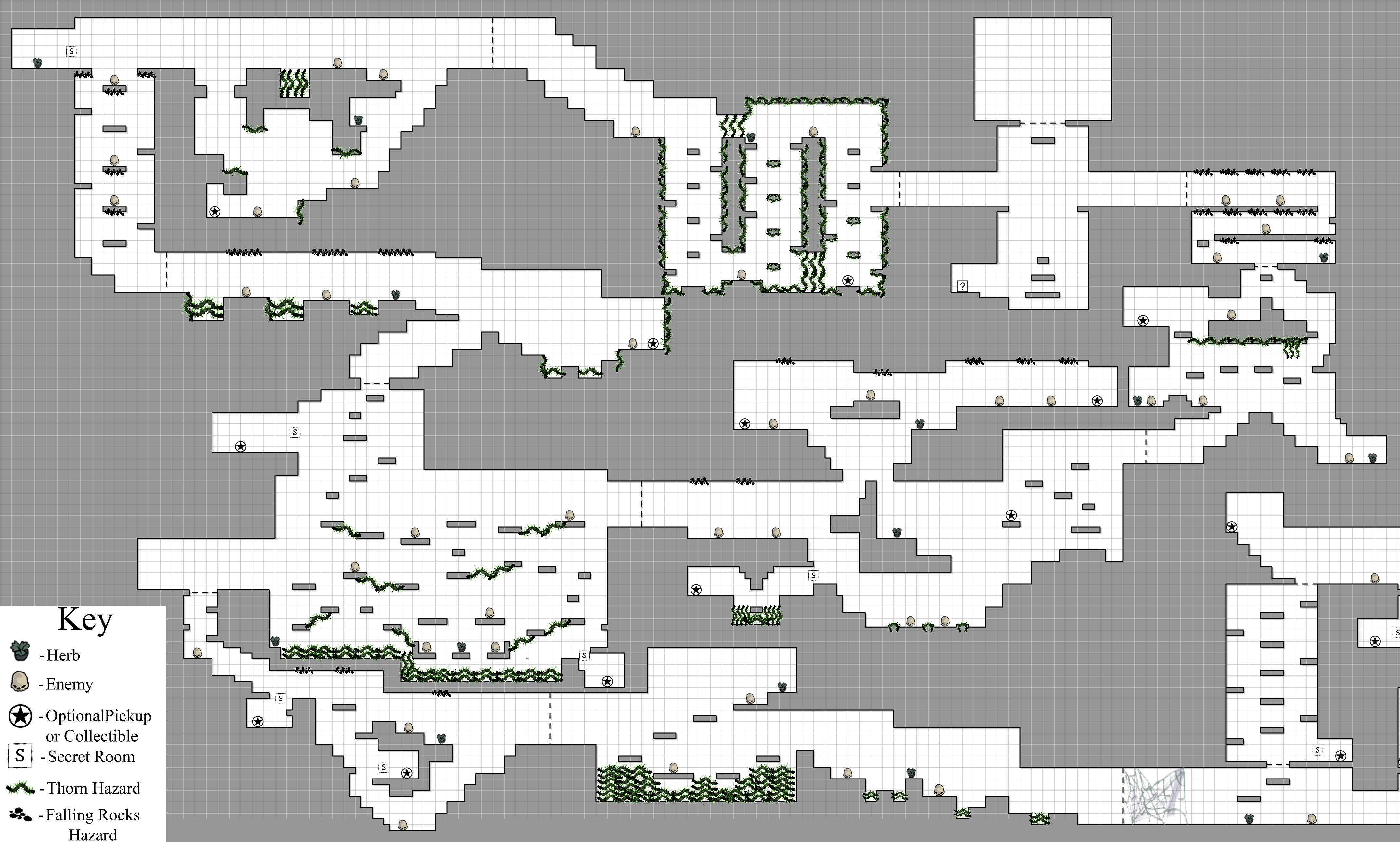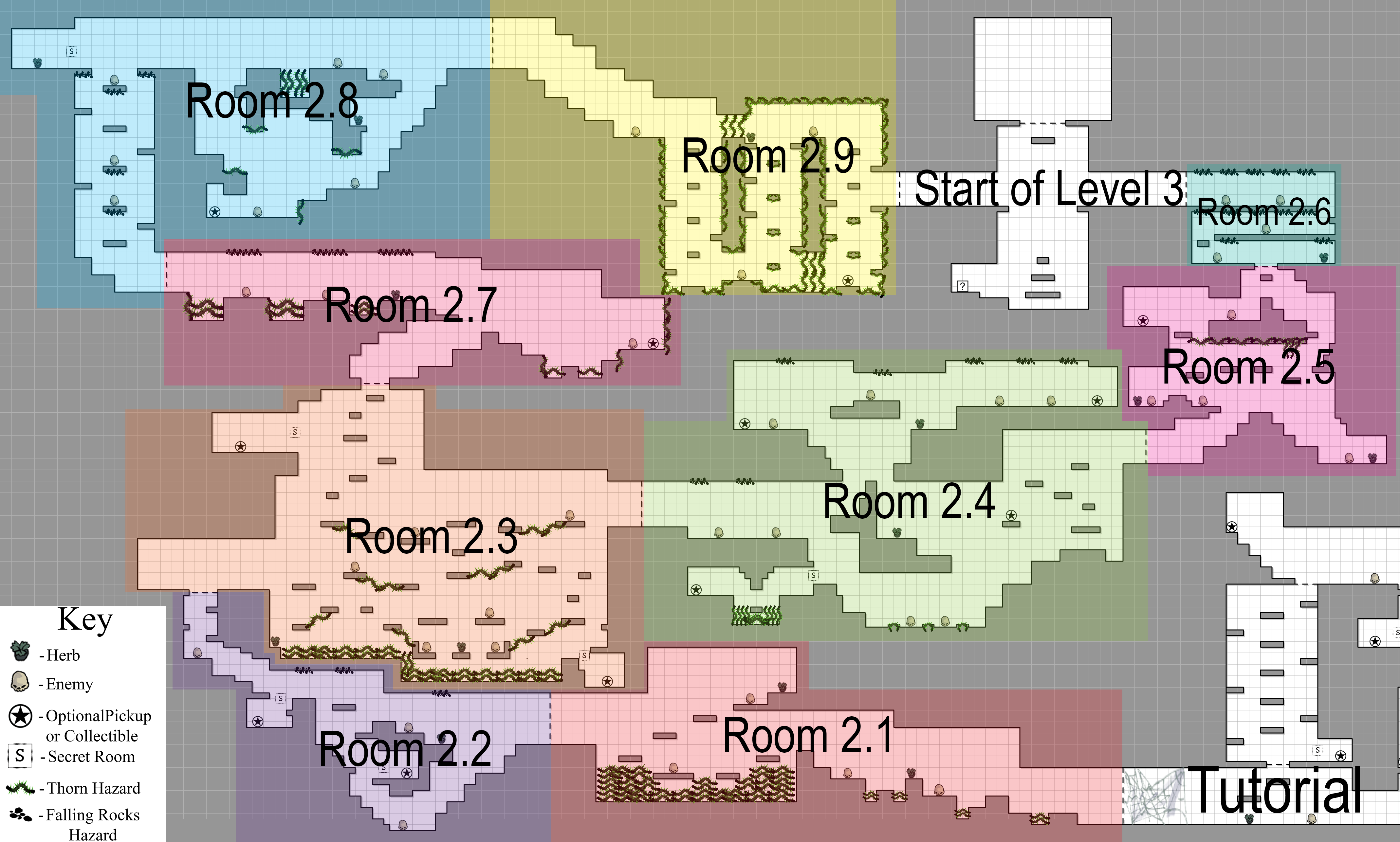Letters from Circe's Island: Dev Log #3

Letters from Circe's Island #3 | Forest Level Design by Jonah Howell
The Forest serves as the second area in the game that the player encounters after starting the game in the Palace. The Forest contains the game's tutorial as well as many other rooms, which follow a more traditional level design, typical of a metroidvania. The Forest post-tutorial contains multiple paths forward, as well as progression locked by a power-up contained in the area.
Tutorial
Any tutorial aims to teach the player how a game's various mechanics work. This tutorial is designed to teach the player the combat of the game, how to jump, how to gather herbs, and to realize the power and value of exploration.



Starting on the right side of the forest, players find themselves in an L-shaped room (room 1.1). Players can see a platform above them, but will be unable to access it at their current position, leaving the only accessible path to drop down to their left. This is where a point of no return is utilized, as once the player drops down to the lower portion of the room, they will be unable to jump back up to their previous location. Points of no return are a somewhat controversial mechanic in metroidvanias due to the player's limited ability to explore. However, I find them helpful and sometimes necessary to ensure players don’t miss certain parts of the game. Although players are unable to progress the game without completing the tutorial, regardless of this point of no return, forcing players to do the tutorial keeps players on track to ensure smooth progression through the early stages of the game. Players now have no other choice but to complete a small platforming segment and enter room 1.2. Room 1.2 is where players find their first herb to collect, as well as some platforms and an entrance into another room above them that is currently inaccessible, as they can’t jump high enough to reach it. Room 1.2 is also where players can find their first Secret Room, a darkened portion of the map that will only become visible once players enter it, usually containing an herb or collectible. After players collect the herb and maybe discover the Secret Room next to it, they drop down into room 1.3. Room 1.3 is where the player finds their second herb, guarded by an enemy. Since this is the player's first combat encounter, I wanted to give the player a long, simple hallway so they can focus on the combat and nothing else. After the player defeats the enemy and collects their second herb, there is a path to their left as well as above. The path to the left is currently inaccessible until the player assists the sailors at the harbor, which gives the player an item to remove the cobwebs blocking their path. For now, the player has no other choice but to go up to room 1.4. Room 1.4 is straightforward in its design, as it's a tall vertical room that players must traverse to get to room 1.5. Room 1.5 covers almost the entire length of the tutorial and is the only room in the tutorial with three entrances/exits. There are also two enemies in room 1.5 to give players a bit more practice with the combat before ending the tutorial. If players go to their left, they will find a dead end with a collectible. If players go to their right, they find an enemy as well as an entrance to drop down into room 1.2 and get access to the collectible on the right side. Further along is another enemy, the final herb to collect in the tutorial, as well as a spot to drop down into the final room of the tutorial. Room 1.6 is small and has a Secret Area on its left and the exit to room 1.1 on its right. When players go into room 1.1, they find themselves on a ledge above the floating platform, originally inaccessible from where they started the tutorial. Players drop down onto the floating platform, then onto the platform where they started the tutorial, completing the tutorial and entering the Palace on their right. This concludes the tutorial.
For the tutorial, there were a couple of aspects I wanted to incorporate. First and foremost, I want to teach players the game's controls in an accessible manner. Herbs are conveniently placed near entrances to new rooms so they weave naturally as parts of the progression. For the tutorial, players must collect three herbs to craft a potion to help the sailors at the harbor, so I wanted to make sure they were placed at points where they would be hard to miss. Enemies are spaced out to allow players to get a grasp on the combat without it being initially overwhelming. I wanted to make sure to teach players that exploring off the beaten path is rewarding. This mostly happens with collectibles in opposite directions of progression, but also with the Secret Rooms. The first Secret Room is placed near the first herb because I want players to “stumble” across the Secret Area on their own. I also want them to find one early, establishing it as something they look for throughout the whole game. Placing the first Secret Area near a point of progression will hopefully lead players to discover it. I also wanted the game to appear non-linear and for the world to be interconnected. The connection of rooms 1.2 and 1.5 is an example of this. Framing the collectible in an inaccessible location and having the player be able to reach it by dropping down from room 1.5 helps the world feel connected. This is also seen in the design of the tutorial as a whole, starting and ending in room 1.1. The last thing I incorporate is alluding to the vine ability found later in the area. The ledge from the right exit of room 1.6 will have vines on it, allowing players to climb up to it from room 1.1. Above that is another ledge with vines, which players can access with their newfound ability.
Level 2



The second portion of the Forest (Rooms 2.1-2.9) is where players will face more of a challenge: more platforming, more enemies, and the introduction of environmental hazards, upping the amount of mechanics players have to juggle. The environmental hazards are initially sparse, allowing players to increase their proficiency. Since it's still early in the game, the overall structure of the second portion of the Forest should be linear. Players get their bearings on the game's controls, and are introduced to environmental hazards such as thorns and falling rocks. However, when the player enters room 2.3, they are met with a choice of proceeding to room 2.4 on the right or room 2.7 up above. Whichever choice players make, they will end up in the same room where they get the vine ability and start the third portion of the Forest. This illusory choice helps gives players a sense of exploration while still allowing progression to be easy-going. This also ensures the player can’t miss the vine ability.
Getting the Vine Ability and Starting Level 3

The third section, which starts in the room where the player gets the vine ability, is where the game becomes more non-linear. This portion is under design, so for this devlog, I’ll only touch on the design of the room where the player finds the vine ability. The room is structured so progression can’t be accomplished without the vine ability. Players are unable to jump to the ledge across the room from whichever side they find themselves on, and players won’t be able to jump up to the platform covered in vines as well. This forces players to drop down into the room and find the vine ability on their left. With the vine ability, players can create a wall of vines connected to the platform above them and either jump to the other side of the room to explore the other half of the second portion of the forest, or they can climb onto the vine-covered platform and jump up to the next room, continuing further into the third portion of the forest. The third portion of the forest heavily utilizes the vine's ability to go forward. It will also have one path which connects back to room 1.1 in the tutorial, and the left side of room 2.3. Players will find both of these rooms before they can fully traverse them. For the connection to room 1.1, I wanted the vine ability to be able to create a shortcut back to the Palace for the players' convenience. With room 2.3, I wanted to ensure that if players decide to immediately tackle the unexplored half of the second portion of the forest after gaining the vine ability, they will have a brand new path to explore instead of having to backtrack to the room that contains the vine ability. This left side will allow players to find the bottom half of the forest as well as be a second path to the top of the forest, where the story will progress.
With the forest acting as the game's tutorial as well as the first explorable area, it required many difficult design choices. So far, the forest has been a fun and challenging design task that I look forward to further exploring. I’m excited to see how it feels when we get it playable in Unity.
Αἰαία
Circe game!
| Status | Prototype |
| Authors | ameliorez, ClownCarCore, EisenIrons, theweze, Ty, Jonah520436, Endoplasmian, dawsonturska |
More posts
- Letters from Circe’s Island: Dev Log #77 days ago
- Letters from Circe’s Island: Dev Log #613 days ago
- Letters from Circe's Island: Dev Log #520 days ago
- Letters From Circe's Island: Dev Log #428 days ago
- Letters from Circe's Island: Dev Log #241 days ago
- Letters from Circe's Island: Dev Log #151 days ago
Leave a comment
Log in with itch.io to leave a comment.